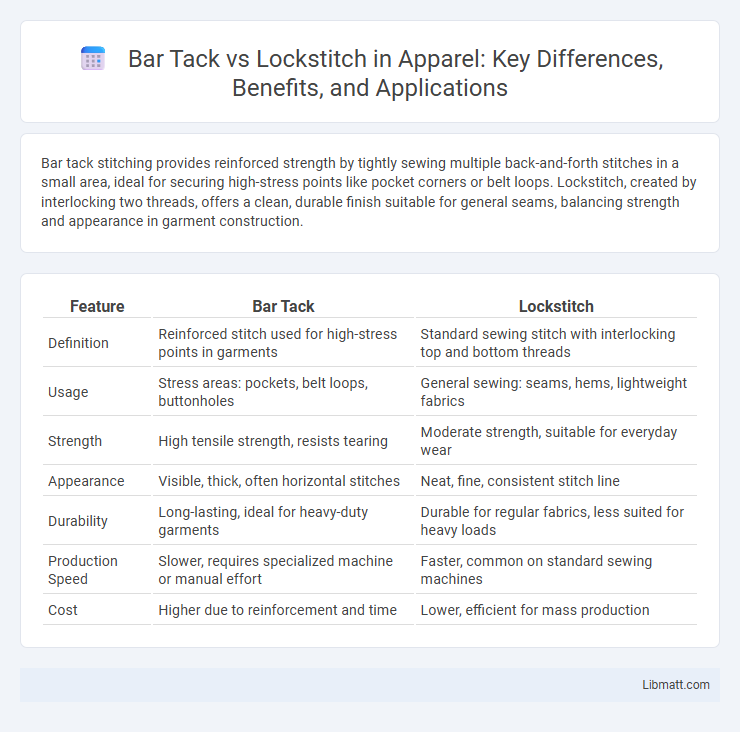Bar tack stitching provides reinforced strength by tightly sewing multiple back-and-forth stitches in a small area, ideal for securing high-stress points like pocket corners or belt loops. Lockstitch, created by interlocking two threads, offers a clean, durable finish suitable for general seams, balancing strength and appearance in garment construction.
Table of Comparison
| Feature | Bar Tack | Lockstitch |
|---|---|---|
| Definition | Reinforced stitch used for high-stress points in garments | Standard sewing stitch with interlocking top and bottom threads |
| Usage | Stress areas: pockets, belt loops, buttonholes | General sewing: seams, hems, lightweight fabrics |
| Strength | High tensile strength, resists tearing | Moderate strength, suitable for everyday wear |
| Appearance | Visible, thick, often horizontal stitches | Neat, fine, consistent stitch line |
| Durability | Long-lasting, ideal for heavy-duty garments | Durable for regular fabrics, less suited for heavy loads |
| Production Speed | Slower, requires specialized machine or manual effort | Faster, common on standard sewing machines |
| Cost | Higher due to reinforcement and time | Lower, efficient for mass production |
Introduction to Bar Tack and Lockstitch
Bar tack and lockstitch are essential sewing techniques used to reinforce fabric in garment construction, with bar tack providing concentrated strength through dense, narrow stitches typically applied at stress points. Lockstitch creates a strong, balanced seam by interlocking the needle and bobbin threads, making it the most common stitch for everyday sewing. Understanding the structural differences between bar tack and lockstitch is crucial for selecting the appropriate reinforcement method in textiles.
What is a Bar Tack?
A bar tack is a series of closely sewn stitches used to reinforce areas of fabric subjected to stress, such as pocket corners or belt loops, ensuring durability and preventing tear. Unlike a lockstitch, which is a standard stitch formed by interlocking two threads, the bar tack specifically focuses on strength through dense, repetitive stitching. You can identify bar tacks by their short, tight, horizontal stitches that secure key points in your garments.
What is a Lockstitch?
A lockstitch is a common sewing stitch created by interlocking two threads, one from the needle and one from the bobbin, producing a strong and durable seam. Unlike the bar tack, which is used for reinforcing stress points with a series of closely spaced stitches, the lockstitch forms the basic seam structure in garments and textiles. Understanding the lockstitch helps you choose the right stitching method for both strength and appearance in your sewing projects.
Key Differences Between Bar Tack and Lockstitch
Bar tack stitching reinforces high-stress areas with densely packed zigzag stitches, enhancing durability in garment sections like pocket openings and belt loops. Lockstitch, created by interlocking upper and lower threads, forms a strong, straight seam commonly used for general construction and visible stitching on garments. The primary difference lies in function and stitch pattern: bar tack provides localized reinforcement while lockstitch offers a continuous seam for assembling fabric pieces.
Strength and Durability Comparison
Bar tack stitches provide superior strength and durability in high-stress areas by reinforcing fabric with multiple overlapping stitches, making them ideal for garment points subject to frequent strain. Lockstitch, while offering a neat finish with interlocking threads, is less resistant to tension and can unravel more easily under stress. Your choice between the two should consider the specific load-bearing requirements of the seam for optimal longevity.
Application Areas in Garment Construction
Bar tack and lockstitch serve distinct purposes in garment construction, with bar tacks providing reinforcement at stress points such as pocket openings, belt loops, and buttonholes to prevent fabric tearing. Lockstitch is commonly used for general seams due to its durability and clean finish, making it ideal for assembling main garment panels. Your choice between bar tack and lockstitch depends on the specific application, balancing reinforcement needs and seam strength for optimal garment performance.
Machinery Used for Bar Tack vs Lockstitch
Bar tack stitching employs specialized bar tack machines designed to reinforce high-stress areas with dense, zigzag stitches, providing durability and resistance to wear. Lockstitch machines, common in general sewing, use two threads interlocked by a needle and bobbin to produce a strong, straight stitch suitable for a wide variety of fabrics and applications. Your choice of machinery depends on the specific structural needs of the garment, where bar tack machines offer targeted reinforcement and lockstitch machines provide versatile, everyday stitching capabilities.
Pros and Cons of Bar Tack Stitching
Bar tack stitching offers enhanced reinforcement at stress points, making it ideal for areas prone to heavy wear such as pockets and belt loops. Its dense, overlapping stitches resist unraveling and provide superior durability compared to lockstitch, which tends to be more general-purpose and less robust under tension. However, bar tack stitching can be bulkier and less flexible, potentially causing discomfort in garments requiring more stretch or smooth seams, so your choice should align with the specific durability needs of the garment.
Pros and Cons of Lockstitch Stitching
Lockstitch stitching offers a clean, professional appearance with high durability, making it ideal for garments requiring a strong, secure seam. It provides precise stitch control and minimal fabric distortion but can be prone to seam unraveling if one thread breaks, potentially compromising the garment's integrity. Compared to bar tack, lockstitch is less suitable for reinforcing high-stress areas but excels in creating long, continuous seams with consistent tension.
Choosing the Right Stitch for Your Project
Selecting between bar tack and lockstitch depends on your project's durability and appearance requirements. Bar tack stitches provide concentrated reinforcement for high-stress areas like pockets and belt loops, ensuring longevity under strain. Your choice should align with the fabric type and the need for strength versus a smooth, versatile lockstitch finish ideal for seams and general stitching.
bar tack vs lockstitch Infographic

 libmatt.com
libmatt.com